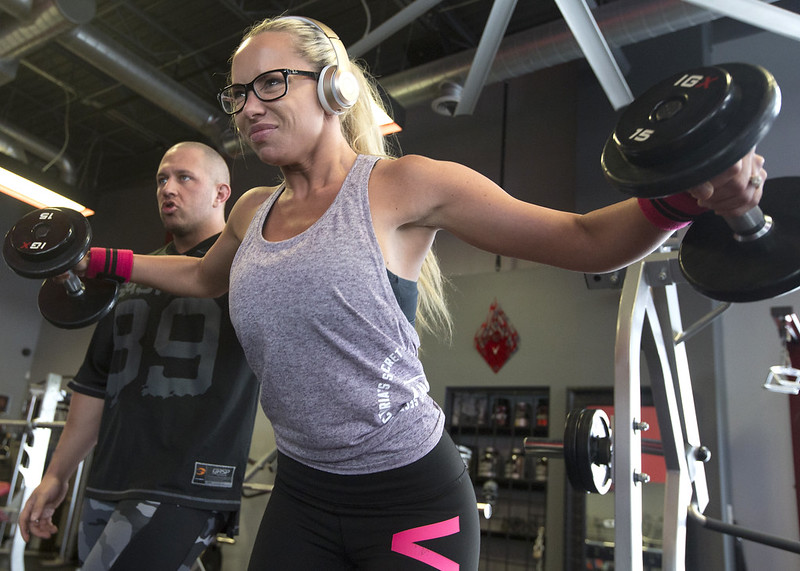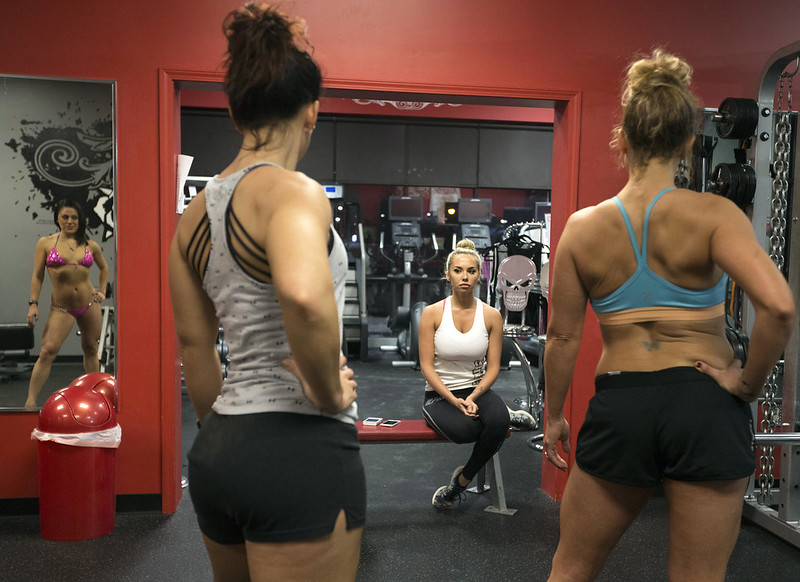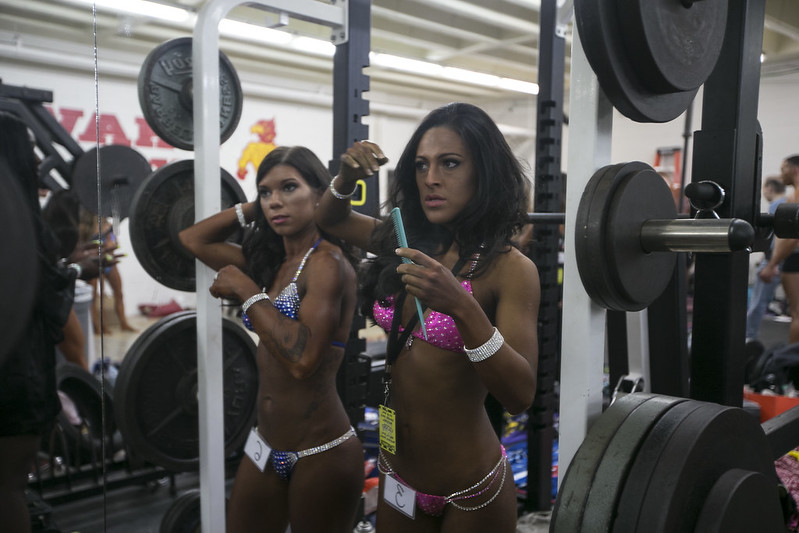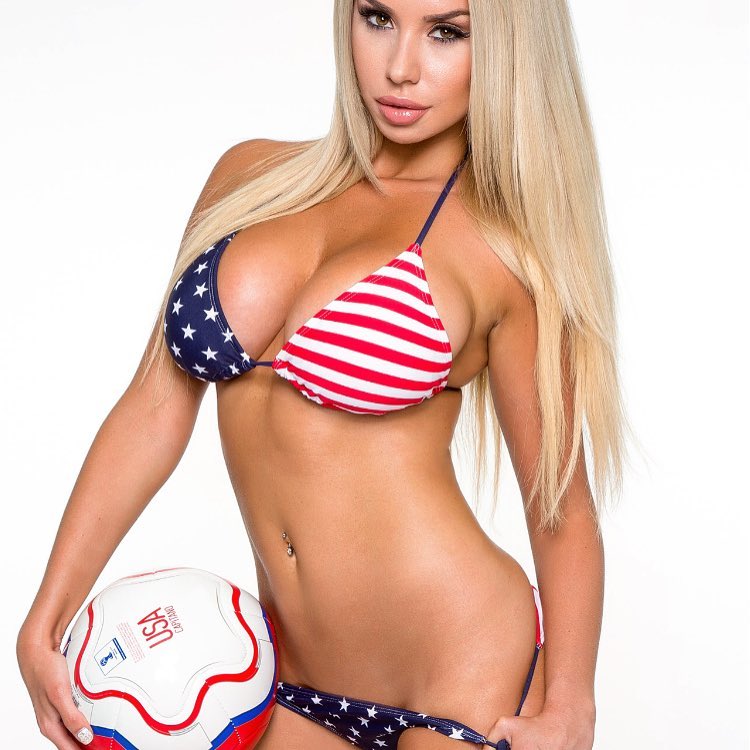 Claudia Fijal’s life has revolved around her image ever since she was 12. That’s when she started modeling, a career that’s led her to an increasingly popular fitness trend.
Claudia Fijal’s life has revolved around her image ever since she was 12. That’s when she started modeling, a career that’s led her to an increasingly popular fitness trend.
“Modeling is the only thing I know,” she said between triceps extensions at Premier Fitness on Rockford’s northeast side. “And one day I’ll wake up and the calls for jobs will have just stopped coming.”
To remain relevant in her industry, Fijal, 27, has taken what some might consider an extreme path to maintain her physique. Fijal has round shoulders, well-defined leg muscles and veins running over her lean abdominal muscles. For the past eight months, she’s crushed 30-second intervals on the StairMaster, pumped iron barbells six days a week and restricted her diet — sometimes eating only white fish and vegetables for days at a time.
The extreme nature of the sport concerns health care professionals, yet bikini bodybuilding continues to grow because of factors such as social media and more female-friendly judging criteria.
“Bodybuilder” isn’t typically associated with long blond hair, manicured nails and contoured eyebrows, but that’s exactly what Claudia is, and she trains for the vanity sport’s newest subcategory, the bikini division.
Women’s bodybuilding has been growing in popularity ever since theInternational Federation of Bodybuilding and Fitness, or IFBB, the governing body of professional bodybuilding, introduced a bikini category in 2010. Since then, the number of professional female competitions has nearly quadrupled around the world.
Rockford is part of the trend. Kevin Noble, the promoter for National Physique Committee, or NPC, the largest governing body in amateur bodybuilding, has organized Rockford bodybuilding shows since 1988. In May, 72 women registered for the bikini division of his biannual show — 41 more participants than the second-most popular division, figure. He said NPC shows in Rockford have become more popular over the past decade, especially since the introduction of the bikini category.
“Bikini has just gone bananas,” Noble said. “The girls can get on stage, get recognized, and still be able to train. The idea is totally hot right now.”
A decade ago, you’d be lucky to see 100 participants in an NPC-organized show, said Daniel Stevens, owner of Premier Fitness. Now, Stevens, who is also an NPC Illinois certified judge, estimates that shows draw an average of 250.
“Ten years ago, if you wanted to lose a lot of weight you’d sign up for a marathon, but now it’s bodybuilding,” he said. “It’s not as much of an underground subculture as it used to be (in the 1980s). It’s becoming more mainstream.”
The sport appeals to women who want to get in the best shape of their lives and lose weight. And they like the recognition.
“We’re in a culture that says you need to stick out rather than fit in, which is uniquely American,” said Diane York Blaine, a University of Southern California professor who specializes in gender studies. “Here in the U.S., we have created the concept of ‘the individual,’ which men have and women want to play, too.”
Fijal met Daniel Stevens nine years ago at a car show, and then reconnected 2 1/2 years ago when he wanted to feature Fijal in an advertisement for Premier Fitness. The couple later married, and Fijal began competing. She uses bodybuilding competitions, and the preparation they require, as a healthier alternative to the crash dieting habits she developed while trying to land modeling gigs in Los Angeles.
“When (agents) would tell me I was too fat for a certain job, I’d run on the treadmill for a couple hours and starve myself until I felt skinny enough to land a different one,” she said.
Stevens, a Rockford native with a background in competitive fitness, personal training and amateur bodybuilding, helped Fijal focus on fitness over thinness.
“When I first saw her, I knew she had serious potential because she’s a tough cookie,” Stevens said. “I knew she could be a masterpiece. Bodybuilders are artists — we see our bodies as a canvas and the weights as our tools.”
With some fitness guidance from Stevens, Fijal started landing more modeling jobs — with big names such as Maxim and ESPN, among others. She was named Kandy magazine’s “2015 Krush of the Year” — the equivalent of Playboy’s “Playmate of the Year” — and recently won her class at a competition in Iowa.
The couple, who refer to themselves as “Fitness Barbie and Ken,” operate Premier Fitness, a mecca for the more obsessive fitness fans in northern Illinois. As business partners, they’re capitalizing on the trend; Fijal uses her modeling experience to coach posing practices, and Stevens uses his background to devise meal plans for a team of eight women.
Haley Pekala was seeking to tone up her legs, lift her butt and attain “boulder shoulders” when she started training with Premier Fitness last winter. She had hit a plateau in her solo workout routine.
“My goal has always been to lose weight, and competing really takes it to the next level,” she said. “I’m not a stick figure, and I don’t want to be … I might keep pushing myself to lose more, but mostly I’m just happy that I’ve gained so much muscle.”
‘Beauty pageant with muscles’
The women’s bodybuilding hierarchy is based on muscle, with the most buff women at the top of the pyramid. There are four categories: bodybuilding, which started in the early 1980s, physique, figure and, most recently, bikini.
The bikini body, meant to appeal to women who want the beach body look, can be obtained in as little as 12 weeks. Judges look for symmetry, tone and femininity — not exaggerated muscles and ripped abdominals.
In the physique and figure categories, judges’ scores are based on a woman’s athleticism and proportion. Athleticism is assessed during a two-minute routine centered on flexibility, strength and endurance. Physique and figure bodies, which require a certain degree of muscle maturity, are attained over the course of months, years and decades.
Conversely, bikini posing practices at Premier Fitness emphasize sass and sex appeal. Competitors perform front and back poses. Noble, the NPC promoter, said the “more well-endowed girls tend to place higher in bikini.”
Most competitors wear hair extensions, stage makeup and clear plastic heels and have long nails and spray tans several shades darker than their natural skin tone. The darker the tan, the more well-defined the muscles look under bright stage lights.
“It’s a beauty pageant with muscles,” Noble said. “Bikini was introduced so women could think, ‘OK, I can pump iron and be muscular and toned, and I can still be feminine and sexy.’”
With bikini competitions on the rise, traditional female bodybuilding, in which women seek to emulate the male physique, is disappearing. The IFBB voted to discontinue women’s bodybuilding at the continental and world levels in 2013, although it still exists in some smaller-scale competitions. Ms. Olympia, the largest professional bodybuilding contest in the world, discontinued the women’s bodybuilding category after its 2014 competition.
Noble followed suit, and the May show in Rockford did not offer traditional women’s bodybuilding. The category “used to be OK in the late ’70s and early ’80s,” he said, but then women started to look “too big.”
“A lot of the women get into the gym and start to see results,” Noble said. “Then they work out more. Then they start using drugs and work out even more. Then they get into that mode where they start getting too big and they can’t see themselves like the outside world does. They become over-muscled by society’s standards.
“The other categories give women a different standard so they don’t get nearly as big or freakish as women used to in (the traditional) bodybuilding division.”
Blaine, the USC professor, said the decline in traditional female bodybuilding reflects cultural expectations that have been around for several hundred years.
“There’s decreased popularity … because of the cultural need to re-establish the idea of opposite sexes,” she said. “When women are getting too independent and too powerful … there always seems to be some kind of backlash that puts women back in their place.
“It seems to me that we’re concerned about females who are in fact able to get muscle and bulk that very much resembles that of men. (Some academics theorize) physical differences are now almost the only ‘proof’ of the superiority over the female. It is the one last bastion of male superiority.”
Women’s body fat percentages are naturally higher than men’s, and reducing that percentage requires a strict diet before competitions. Ask any competitor about the worst part of the journey, and she’ll tell you it’s the diet. She’ll also tell you that without a strict diet, she won’t win.
The diet
June Darling’s path to scoring a bikini bodybuilding trophy started with five or six lean meals a day.
Every Sunday, Darling prepared her meals for the following week according to a plan provided by Stevens. During the weeks leading up to her second competition of the year, she weighed portions of white fish on a food scale, baked a few pans of green asparagus, and then divided the food into plastic containers. She usually eats separately from her husband and son, who do not adhere to meal plans.
An Army veteran, Darling started working out as a way to pass the time when she was stationed in Korea. Fitness then became a lifestyle she carried with her back to the U.S. Competition has become “addictive,” she said.
“When I’m not prepping for a show, I don’t really know what to do with my diet. I get used to eating (several) small meals throughout the day, and if I’m not working out then I can’t eat like that anymore. It’s really hard to make that switch.
At the start of a training cycle, Stevens said, the women go with the “God diet; if he made it, we can eat it.” Over time, however, meal plans change and certain foods are subtracted from the plan. By “peak week” — the week leading up to the competition, also known as “hell week” by the bikini competitors — food is restricted mostly to several meals of white fish and vegetables — even for breakfast. In the 24 hours leading up to a show, competitors do not drink water so they don’t appear bloated.
Shirley Poole, a registered dietitian and nutritionist at Rockford Health System, said the rapid weight loss and strict diet can come as a shock to the body.
“In order to lose weight so quickly, the (competitors) have to be starving themselves to some degree. And when you’re only eating from one or two food groups you will have a nutrient deficiency. If you look at this from a broad point of view, it’s socially acceptable anorexic behavior.”
Stevens said that he knows the gym attracts “borderline obsessive personalities,” but that he strives to teach balance.
“When it comes to preparing, we tell them to put the mirrors away,” he said. “We give them cheat meals where they can eat whatever they want. We tell them not to get upset about how much they weigh because the number is irrelevant.”
None of the women train year-round, and they acknowledge that their bodies could use a break from the extremes. Transitioning out of the sport can be difficult on the body and mind, however.
“I would guess the vast majority of the competitors become addicted to this lifestyle, so when it’s time to cycle out (of show preparation) we try to reintroduce foods into the diet over a few weeks’ time. We call it ‘the rebound period,'” Stevens said. “But sometimes you get the extreme people who immediately start eating junk again. Then they gain the weight back quickly.”
Competitor Haley Pekala said she welcomed a break from the pressures of show prep after competing in May. But with time off came a vacation, and with a vacation came some “unhealthy” eating.
“At this point, I still want to have more muscle mass and lose more weight. But when are you really going to be happy? You always want to improve.”
The yo-yo dieting doesn’t sit well with Emilie Lindsay, a nutritionist at Van Matre Rehabilitation Hospital in Rockford. She said she won’t work with bodybuilders because the desired results are not what she considers healthy.
“It’s a very slippery slope when a sport or diet revolves around numbers, like how low you can get your body fat percentage. This kind of lifestyle can harm your metabolism, your bones and your cognition,” she said. “I preach the ‘everything in moderation’ concept.”
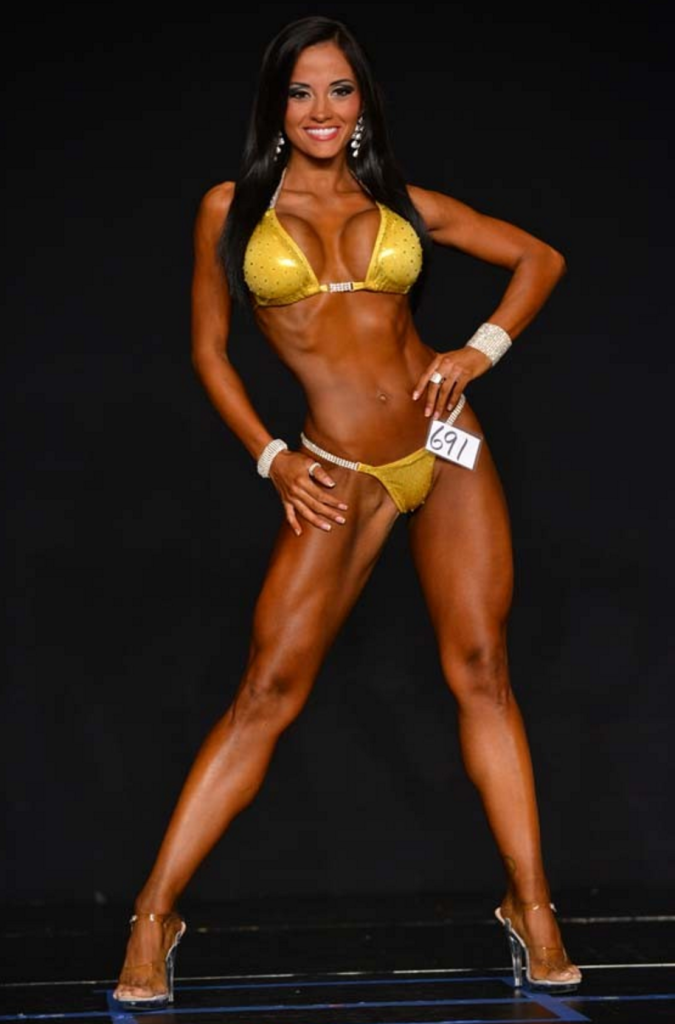
‘It’s worth it’
Although women’s bodybuilding is gaining popularity, it remains an elite sport. It can cost thousands of dollars to prepare for a single show when factoring in the expense of a good coach, an official NPC membership card, fresh food, professional hair and makeup and health supplements. A typical competition swimsuit runs north of $550. Some women go so far as to pay for breast implants in an attempt to look more feminine after losing their subcutaneous layer of fat.
Amateur competitors usually win trophies, T-shirts and glory. Winners also advance to a national competition, where they have a shot at attaining “pro” status.
“A modern, fit female’s appearance suggests that she has the money and the time to control her body and face,” Blaine said. “These women are seeking achievement and status, and I’m sure a lot of them are privileged.”
Poole said the long-term health risks aren’t visible to the competitors.
“I don’t think we know as much as we want to know,” she said. “The question is, how does this damage you internally? Are you destroying heart muscles by overexercising? Losing the fat that protects your vital organs? How balanced are your hormones?”
Despite the costs and potential health risks, Fijal credits the sport with giving her a much-needed lifestyle change.
“After living in LA, the fitness route was hard to get used to, but it is so much better,” she said. “I wish I could tell those girls who are out there (who are crash dieting) that this is a much healthier lifestyle.”


